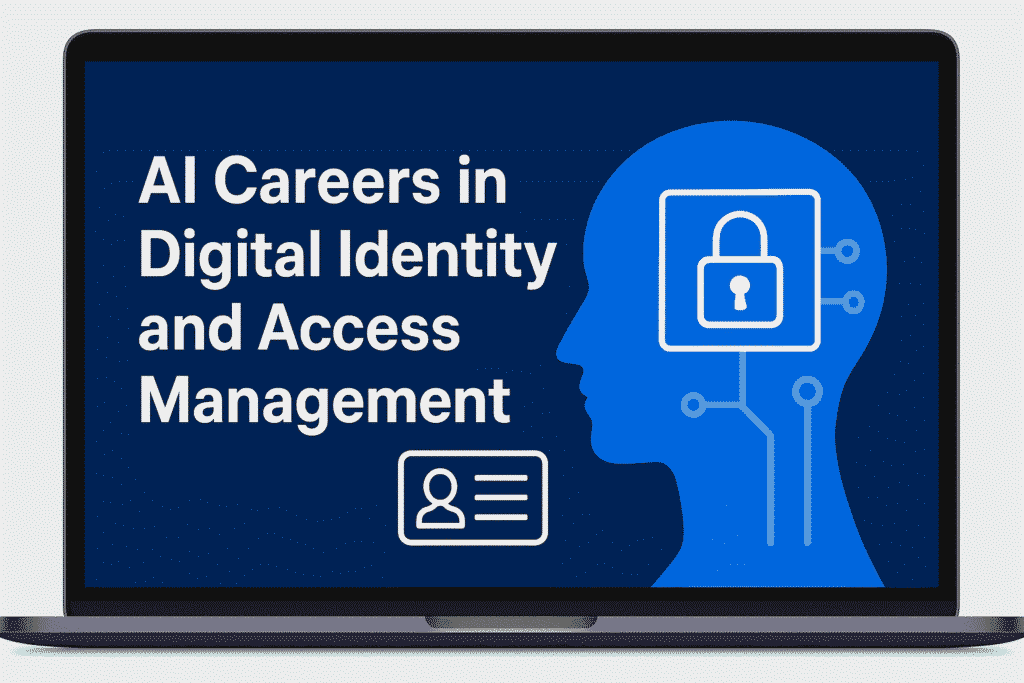Introduction
In today’s digital world, identity is increasingly becoming the new perimeter. As organizations move more services to the cloud, adopt mobile-first strategies, and rely on remote or hybrid workforces, securing who has access to what, when, and how is critical. Identity and Access Management (IAM) is the discipline and set of technologies responsible for ensuring that the right individuals (or machines) have access to the right resources at the right times, with the right permissions—and no more.
AI (Artificial Intelligence), and associated technologies (machine learning, behavioural analytics, anomaly detection, etc.), are now transforming IAM. AI can make IAM smarter, more adaptive, more automated—and more secure. AI‑driven IAM roles are growing fast, because manual IAM is not enough against modern threats: credential theft, identity fraud, insider threats, bot‑driven attacks, and more.
This article explores how AI is shaping IAM careers, what roles exist, what skills are needed, what the future looks like, and how you can build a successful career in AI‑powered IAM.
Table of Contents
In the modern digital era, identity has become the cornerstone of every online interaction. Whether you are logging into a mobile banking app, accessing a corporate VPN, making an e-commerce purchase, or interacting with a government portal, your digital identity plays a crucial role.
As businesses and individuals embrace digital transformation, the need for strong identity and access management (IAM) has reached unprecedented levels. This need has been accelerated by factors like:
- Rise of remote work: Millions of employees now work from home, requiring secure access to organizational systems.
- Cloud adoption: Companies rely heavily on cloud services such as AWS, Azure, and Google Cloud.
- IoT and connected devices: Billions of devices worldwide require secure identification and communication.
- Cybercrime surge: Cyberattacks, identity theft, and data breaches are at an all-time high.
Traditionally, IAM solutions were rule-based and static, relying on usernames, passwords, and role-based access controls. While these worked in simpler times, today’s fast-paced, highly dynamic digital landscape demands something far more intelligent and adaptive.
Enter Artificial Intelligence (AI) — a transformative technology that is revolutionizing IAM by making it smarter, faster, and more secure.

What is Digital Identity?
A digital identity is the electronic representation of a person, device, or organization. It includes:
- Identifiers: Unique data such as usernames, email addresses, or biometric scans.
- Credentials: Proofs of identity like passwords, PINs, or digital certificates.
- Attributes: Characteristics like job role, department, or access level.
For example:
- Your Facebook login credentials form your social identity.
- Your Aadhaar number (India) or Social Security Number (US) is a government-issued digital identity.
- A corporate employee ID combined with security tokens forms an enterprise identity.
Digital identities are now critical assets. They determine who can access what resources in the digital world. With billions of people and devices connected globally, managing these identities securely has become a monumental challenge.
What is IAM, and How AI is Intersecting IAM
IAM involves:
- User identity lifecycle: onboarding, role change, offboarding
- Authentication: verifying that a user is who they claim to be (passwords, MFA, biometric, etc.)
- Authorization: deciding what a user / system is allowed to do (roles, policies, permissions)
- Access governance: periodic review of who has access, auditing, compliance
- Privileged access management (PAM): securing, monitoring, and auditing accounts with elevated privileges
- Federation, Single Sign‑On (SSO), protocols (SAML, OAuth, OpenID Connect, etc.)
- Identity data stores: directories (LDAP, Active Directory), identity providers (IdP), identity governance platforms
AI / ML add to IAM in various ways:
- Anomaly detection: spotting unusual login patterns, access requests, or privilege escalations
- Behavioural analytics: understanding normal user behaviour and flagging deviations (e.g. time, location, device)
- Adaptive / risk‑based authentication: asking for more proofs (additional MFA, challenge questions) when the risk is higher
- Automated policy generation / optimisation: using AI to suggest or refine access control policies, role definitions, least privilege assignments
- Identity fraud detection: detecting synthetic identities, identity theft, account takeover
- Provisioning / lifecycle automation: automating granting/removing access, deprovisioning, offboarding, integration with HR / directories etc.
- Identity proofing & verification: using biometrics, document verification, liveness detection, etc.
So, AI doesn’t replace IAM—it empowers IAM with scalability, speed, context, and intelligence.
Key Roles & Career Paths in AI‑Enhanced IAM
Here are some of roles you might find in IAM, especially in organizations that are embracing AI. The path tends to go from entry → mid → senior / leadership. Also, some roles will be more hands‑on technical; others more strategic, architectural, or managerial.
| Level | Role Title | Typical Responsibilities with AI focus |
|---|---|---|
| Entry / Junior | IAM Analyst / IAM Administrator / IAM Operations Specialist | Handle access requests, user/on‑off boarding; monitor alerts; basic policy enforcement; learn the tools. In AI contexts: assist with anomaly detection dashboards, support MFA, manage identity proofing, monitor false positives/negatives. |
| IAM / Identity Engineer (Junior) | Configuration of IAM systems (SSO, MFA, federation); scripting for automation; integrating identity providers; building connectors. Assist in implementing AI modules (e.g. integrating behaviour analytics, riskbased rules). | |
| Mid‑Level / Intermediate | IAM Engineer / AI‑IAM Specialist | Lead IAM integrations, design and implement SSO / federated identity, role & entitlement management. Work with ML teams on detecting abuse, building threat models. Set up adaptive authentication. Implement privileged access management (PAM). Ensure tools / pipelines for identity lifecycle automation. |
| IAM / Identity Security Analyst / Threat Detection Specialist | Focus on security: detecting suspicious access, account takeovers, insider threats. Use AI / ML to monitor logs, user behaviour, anomalous patterns. Investigate alerts, tune detection systems. | |
| IAM Consultant | Work across clients or business units. Design IAM frameworks and governance. Advise on AI enhancements (behavioural risk, anomaly detection, etc.). Aid in tool selection, vendor evaluations. | |
| Senior / Leadership | IAM Architect / Identity Architect | Design large-scale identity & access infrastructures. Define strategy for IAM + AI, including zero‑trust, least privilege, identity federation, policy enforcement at scale. Oversee integrations, security/breach response, compliance. |
| Security / IAM Manager / Director / Head of IAM / Head of Identity Security | Lead teams; define IAM strategy; manage budgets; ensure IAM practices meet regulatory / audit standards; align IAM initiatives with business risk and goals; ensure AI‑based IAM tools are well governed, privacy‑compliant. | |
| Privileged Access Management (PAM) Specialist | Could be more senior. Oversee controls for high‑privilege accounts; ensure just‑in‑time / just‑enough access; integrate with AI for anomaly detection or for monitoring of privileged sessions. | |
| Governance, Risk & Compliance (GRC) Specialist in IAM | Focus on audit, policy, compliance (e.g. GDPR, HIPAA, PCI‑DSS, SOX). Use AI / automation for evidence collection, reporting, risk assessments. | |
| Emerging / Specialized Roles | Identity Data Scientist / IAM ML Engineer | Work at the intersection of IAM and data science: building threat detection models; working with large datasets of logins, access patterns; refining false positives; feature engineering of identity behaviour signals. |
| Ethical AI / Privacy Officer for IAM | Given IAM involves sensitive personal / access data, privacy, fairness, bias must be managed. Someone needs to ensure that AI modules in IAM respect privacy, don’t discriminate, and meet GDPR / CCPA etc. | |
| AI Agents / Autonomous Identity Roles (emerging) | With more AI agents (bots, services, autonomous agents), identity needs expand beyond human users: agent identities, how they act, delegation, governance of what agents are allowed to do. Roles around authenticating & authorising AI agents are growing. |
What Employers Look for: Skills, Tools & Competencies
To succeed in IAM roles that incorporate AI, you’ll need a mix of technical skills, security domain knowledge, plus some soft skills. Here’s a breakdown.
Technical Skills & Knowledge
- Identity protocols & standards: SAML, OAuth 2.0, OpenID Connect (OIDC), SCIM (System for Cross‑domain Identity Management), LDAP, Kerberos.
- Authentication / Authorization models: RBAC (Role‑Based Access Control), ABAC (Attribute‑Based), PBAC, Zero Trust, least privilege.
- Identity lifecycle management: provisioning, deprovisioning, role changes, offboarding, identity proofing.
- Privileged Access Management: managing accounts with elevated rights, just‑in‑time (JIT) access, session monitoring.
- Security & Access Governance: audit, compliance, access reviews, entitlement management.
- Cloud IAM: AWS IAM, Azure AD / Entra, Google Identity, identity across multi‑cloud or hybrid setups.
- Federated identity / SSO / Identity Providers (IdPs): knowledge of how to integrate with external identity providers; cross‑organization identity federation.
- Automation & scripting: Python, PowerShell, Bash, or your organization’s scripting stack. Automating mundane tasks, provisioning, alerts, workflows.
- Machine Learning / AI basics: understanding of ML models, training, evaluation, anomaly detection, unsupervised vs supervised learning, dealing with data quality, false positives / negatives.
- Data analytics / log management / SIEM: being able to analyze logs, set triggers, model behavior changes, monitor dashboards; familiarity with tools like Splunk, ELK, Azure Sentinel, etc.
- DevOps / Infrastructure as Code (IaC): Terraform / CloudFormation / ARM / Bicep; in many roles IAM services need to be codified, reproducible.
- Privacy, security compliance & regulatory awareness: GDPR, HIPAA, SOX, PCI‑DSS. Data protection, least privilege, data minimization, privacy by design.
Soft Skills / Business Skills
- Communication: Stakeholder management, explaining technical trade‑offs to business or leadership.
- Risk mindset: understanding threat models, risk assessments, impact of breaches.
- Problem solving & curiosity: investigating weird behaviour, edge‑cases, evolving threats.
- Attention to detail: IAM mistakes can cause major vulnerabilities.
- Project management: many IAM tasks are cross‑team, multi‐stakeholder; you’ll need to work with HR, legal, operations, development, audit.
Certifications & Education
Certifications can help you stand out, especially as many IAM tools are vendor‑heavy or regulated. Some useful certifications / education paths:
- Formal education: Degree in Computer Science, Information Security, IT, or related field. If possible, specialization or coursework in security, networking, AI / ML.
- General security certs:
- CISSP (Certified Information Systems Security Professional)
- CISM (Certified Information Security Manager)
- CompTIA Security+
- Vendor / product specific & IAM focused certs:
- Microsoft certifications (e.g. Azure Identity, Azure Security)
- Okta Certified Administrator, Okta Certified Engineer
- SailPoint Certifications (e.g. IdentityNow, IdentityIQ)
- CyberArk / BeyondTrust etc for PAM tools
- Certified Identity and Access Manager (CIAM) / Certified Identity Professional (CIP) / etc.
- AI / ML / Data Science certifications: if you are going toward analytics, fraud detection, behaviour analysis or agent‑based identity work, certifications or courses in ML, data science, AI ethics are helpful.
- Compliance / governance / risk: Certifications or training in GDPR, privacy laws, SOX, etc.
- Continuous learning: because IAM + AI is evolving, following research papers, attending conferences, engaging in webinars is important.

Salary Expectations & Market Demand
IAM is now considered a core part of security and risk management, especially with remote work, cloud adoption, and AI threats. Below are rough estimates and observations (they vary by geography, company size, sector, skill set).
- Entry level / junior IAM roles tend to start lower (in many places, modest). But even early IAM roles can pay well, especially if you have cloud skills, scripting, or exposure to AI / data analysis.
- Mid‑level IAM Engineers / Analysts with AI / automation / threat detection responsibilities command increasingly higher salaries.
- Senior / leadership IAM Architects, IAM Security Managers, or those specializing in PAM, AI‑based threat detection, or in regulated sectors (finance, healthcare, government) often see very strong remuneration.
- In India, IAM roles are growing in demand. Many companies are hiring IAM Engineers, IAM Security roles, PAM specialists etc. As per some recent Indian sources, mid to senior IAM roles can see salaries in the scale of ₹15‑30 lakh+ for senior hands, depending on company, tool stack, location. Freshers or junior folks might be in lower band, but with growth possibilities. (This is approximate and subject to many variables.) [From DVrtta IAM salaries in India] DVrtta
- In the US / Europe, roles are higher, sometimes well over $100,000 USD for senior engineers / architects. IAM Architects or Directors may reach $150,000‑250,000+ depending on location, company, responsibilities. (Seen in some job listings) Gartner Careers+3Dassault Systèmes+3OpenAI+3
- Salaries also vary substantially by tool stack (e.g. IAM with SailPoint / CyberArk / Okta etc), by cloud vs on‑prem, by how much AI / ML work is involved, by regulatory burden (finance / healthcare / regulated industries tend to pay more).
Real‑World Examples & Job Descriptions
It helps to see what actual job postings are asking for. Here are a few recent IAM / Identity / IAM‑AI‑adjacent roles, to give you a sense of what employers want.
- IAM Engineer, OpenAI — role includes managing identities and access using AzureAD, automating provisioning / de‑provisioning, optimizing IAM workflows, ensuring compliance and proper access control. OpenAI
- Security Engineer – IAM (Gartner, Gurgaon, India) — use of authN/authZ, federation protocols (SAML, OIDC), scripting (Python / PowerShell), LDAP, Active Directory, privilege access management in cloud & on‑premise. Gartner Careers
- Information Security IAM Architect, Medidata — designing IAM solutions, automating identity lifecycle, federated identity, MFA / SSO, zero trust, integration across cloud and on‑premise environments. Dassault Systèmes
- Senior IAM Engineer, EPAM Systems — configuring identity tools (Okta, Saviynt), writing Terraform configurations, integrating applications, using modern protocols etc. LinkedIn
- Digital Global Identity and Access Manager (Carrier, Hyderabad, India) — leading IAM globally, bridging cloud/on‑prem, enforcing policies, integration, performance, security. Carrier Jobs
These jobs often demand hands‑on technical skill and strategic thinking, especially if AI / automation / risk detection features are involved.
Industry Trends & What’s Next
Understanding where things are heading helps you steer your career accordingly. Here are some of the major trends in IAM + AI / related developments:
- Zero Trust and Least Privilege
Many organizations are moving to zero trust architectures, where implicit trust is minimized. Access is granted on a need basis, continuously verified. AI helps by assessing risk in real time (device posture, location, behavior). - Identity as a Service (IDaaS)
More tools are shifting to cloud‑based identity services. Cloud providers (Azure, AWS, Google) offer identity platforms. Vendors like Okta, Auth0, etc. Growing demand for hybrid identity, federated identity, identity portability. - Adaptive / Risk‑Based Authentication & Policy
Instead of static policies, more adaptive policies are being used: if a login is from unusual location or device, request stronger authentication. AI / risk engines are central to that. - Behavioural Biometrics, Continuous Authentication
Monitoring behavior patterns (typing, mouse, gestures, device usage) to continuously verify identity. - Identity of Machines, Services, AI Agents
Non‑human identities are exploding (API keys, service accounts, machine identities, AI agents). Managing their identities, permissions, revocations are complex. Decentralized Identifiers (DIDs), verifiable credentials, etc. are research areas. arXiv+2arXiv+2 - AI / ML for Monitoring, Detection, Automated Remediation
Using AI to detect threats in real time, flag suspicious access, automatically block suspicious sessions, recommend changes to policies. - Privacy, Ethical, Regulatory Pressures
As identity management deals with personal data, privacy is key. Data minimization, protection, fairness. Regulations (GDPR, CCPA, etc.) increasingly influence IAM designs. - Integration with DevOps / DevSecOps
IAM is integrating earlier in the software lifecycle—securing CI/CD pipelines, infrastructure, microservices. Identity is not just about end users any more; it’s about services talking to services. - Automation & Infrastructure as Code (IaC)
Reproducible, auditable provisioning; policies codified; automated off‑boarding / entitlement reviews; compliance by design. - Focus on Identity Governance and Administration (IGA)
Tools like SailPoint, Saviynt, iGA are gaining traction. Governance (who can do what), certifying entitlements, reviewing access, segregation of duties (SoD) issues.
Challenges & Risks
As exciting as AI + IAM is, there are also pitfalls, risks, and challenges you should be aware of if you pursue a career in this domain.
- False positives / negatives: Anomaly detection works but can generate noise. Too many false positives frustrate users; too many false negatives compromise security.
- Data quality & quantity: ML models need good data. Incomplete logs, missing context make models less effective.
- Privacy / Ethical issues: Behaviour tracking, biometrics, AI agents, etc. expose sensitive data. You need to balance security with user privacy.
- Regulation & compliance: Laws differ across regions; sensitive sectors have stricter controls. IAM practices must be auditable, traceable.
- Tool sprawl / complexity: There are many tools, vendors, protocols. Integrating all, managing compatibility, avoiding security holes is complex.
- Managing non‑human identities: Machines, APIs, service accounts, agents require identity control too. Their lifecycle, credential management, access revocation need careful handling.
- Scalability: As organizations grow (more users, more services, more cloud), IAM systems must scale, while maintaining performance, security, user experience.
- User experience vs security trade‑offs: Stricter policies may impair usability; balance is critical.
- Evolving threat landscape: Attackers constantly find new vectors (identity phishing, credential stuffing, AI adversarial attacks). IAM professionals must stay current.

How to Get Started & Grow in IAM + AI
Here are practical steps you can take if you’re building a career in AI‑powered IAM.
- Build foundation in IAM fundamentals
Learn identities, authentication, authorization, identity lifecycle, common protocols (SAML, OAuth, OIDC), directory services. Understand cloud IAM, on‑prem IAM. - Learn security basics
Information security, network security, risk management, threat modelling. - Pick IAM tools and platforms
Get familiar with major IAM / IGA / PAM tools (Okta, SailPoint, CyberArk, Azure AD / Entra, Ping Identity, etc.). Try to do small projects or labs. - Learn scripting / automation
Learn Python, PowerShell, or other relevant languages. Automate repetitive IAM tasks (user provisioning, access reviews etc.). - Gain exposure to AI/ML & data analytics
Even basic knowledge: features / logs, understanding how anomaly detection works, thinking about what signals matter. Maybe take courses or build sample projects. - Work on real‑world projects
Internships, academic projects, open source, or within your company. E.g. implementing SSO, integrating MFA, building automated workflows. - Pursue certifications
Especially vendor / product specific ones, and general security ones. They boost credibility. - Network & learn continuously
Attend IAM / security conferences, webinars, meetups. Read blogs, research papers. Follow emerging topics like identity of AI agents, decentralized identity. - Choose a niche or specialization
For instance, specializing in PAM, or IGA, or cloud IAM, or identity fraud detection, or AI agent identity. Being deeply skilled in one area plus broadly competent in many is valuable. - Soft skills & business awareness
Communication, stakeholder management, compliance understanding. You’ll often need to explain to non‐technical stakeholders why identity matters, what risks are, what trade‑offs you need.
Forecast: Where the Future Lies
Looking ahead, here are key directions IAM + AI careers are likely to go in:
- Agentic IAM: As AI agents, bots, microservices proliferate, identity for non‑human agents will need strong frameworks (delegation, accountability, revocation etc.). Research such as “A Novel Zero‑Trust Identity Framework for Agentic AI” is pointing toward decentralized, fine‑grained control. arXiv
- Federated, Decentralized & Verifiable Identity: DIDs (Decentralized Identifiers), verifiable credentials, blockchain / SSI (Self‑Sovereign Identity) are gaining attention. Control, privacy, user data ownership will matter.
- Trust & Privacy Preserving ML in IAM: Using techniques like differential privacy, zero‑knowledge proofs, to do behaviour analytics or fraud detection without compromising user privacy.
- Adaptive Identity Risk Engines: Real‑time risk scoring of access requests; dynamic access policies based on a combination of behavior, identity, device posture, location.
- AI / ML generating policies: More AI‑driven policy suggestion engines; though human oversight will remain crucial.
- Better tooling that integrates identity across cloud, microservices, APIs, mobile, IoT devices. IAM professionals will work more with platform engineering.
- Stricter regulation globally governing identity, data, privacy. IAM practitioners will need to be conversant with legal, regulatory demands.
How to Position Yourself Uniquely
To thrive, it’s helpful to differentiate yourself. Here are ways to do that:
- Combine IAM + AI/ML expertise: Not many people are strong in both. Even if you’re primarily IAM, getting solid data analytics / ML knowledge gives you an edge.
- Get good at non‑human identity management: service accounts, AI agents, API identities. That’s an increasingly important area.
- Master one or more popular IAM / IGA / PAM tools deeply; being vendor‑agnostic helps too.
- Gain experience in regulated sectors (finance, healthcare, government). They often pay more and have tougher requirements.
- Put emphasis on privacy, ethics, fairness: These issues are no longer optional.
- Build a portfolio: maybe write about IAM topics, contribute to open source / labs, do small projects or case studies.
- Understand risk / threat modelling: being able to translate security risk to business risk is very valuable in senior roles.
Sample Career Path Timeline (What progress might look like)
Here’s an example of what your progression might look like over years, for someone starting fresh but aiming high.
| Years of Experience | Possible Role | What You’ll Be Doing | Skills You’ll Have Gained |
|---|---|---|---|
| 0‑1 year | IAM Analyst / Junior IAM Ops | Handling user onboarding/offboarding, managing access requests, helping with access reviews, basic MFA, SSO config help. | Protocols (SAML, OAuth), basic scripting, understanding of IAM lifecycle, attention to detail. |
| 1‑3 years | IAM Engineer / Identity Engineer / IAM Specialist | Full responsibility for IAM integrations, building automation, implementing adaptive authentication, helping in detection / alerting of anomalies, working with cloud IAM. | Strong scripting, cloud identity, more knowledge of security, basic ML/analytics work, project work, tool stack (Okta, SailPoint etc.). |
| 3‑5 years | Senior IAM Engineer / Security Analyst / Consultant | Designing IAM frameworks, integrating complex systems, implementing PAM, driving AI / ML features, working with governance & compliance, possibly leading small team. | Leadership skills, design and architecture, threat detection, risk management, deeper knowledge of tools, perhaps some AI/ML modelling. |
| 5‑8 years | IAM Architect / IAM Security Manager / Director | Overseeing entire IAM strategy, architecture, identity governance, policy, integrating AI‑assist, zero trust, alignment with business goals, leading teams, negotiating tool/vendor decisions. | Strategic thinking, stakeholder management, budget, governance, cross‑domain knowledge (security, compliance, privacy, tools, cloud, agentic identities). |
| 8+ years | Head of IAM / Identity Security Director / CISO (or specialization) | Setting vision for identity security, shaping policy at organisational / industry level, leading large teams, maybe overseeing identity risk, AI agent identity, non‑human identities, privacy across identity. | Deep domain authority, broad leadership, global perspective, running IAM at scale, balancing innovation & risk. |
Why This Is a Good / Strong Career Choice
- High demand: As more organizations digitalize, use cloud, remote work, regulatory scrutiny, IAM becomes a linchpin of security.
- Impact: IAM work directly reduces risk. Many data breaches involve compromised credentials / identity. You’ll be doing work that prevents serious harm.
- Continuous learning: The field evolves—new threats, new tools, AI integration, more non‑human identities, regulations. So there is always something new to learn.
- Good compensation: Mid to senior roles are well paid, especially with specialized skills or working in regulated sectors.
- Versatility: Skills transfer across industries (finance, healthcare, tech, telecom, government), across geographies. Often IAM roles can be remote or hybrid.
- Path to leadership / specialized niches: Many directions—architecture, compliance, privacy, AI security, risk, agent identity etc.
Possible Entry Barriers & How to Overcome Them
- Barrier: Lack of experience / projects.
Solution: Do labs, side projects, contribute to open source. Try to get exposure to IAM tools; set up small identity management systems or simulate role based access etc. - Barrier: Understanding AI/ML can be intimidating.
Solution: Begin with basics: how anomaly detection works, get comfortable with statistics, maybe take a course in ML fundamentals. Use existing tools / dashboards to see real‑world examples. - Barrier: Tool / vendor fragmentation. Learning which tools are relevant in your market matters.
Solution: Pick one or two popular ones in your region; also keep an eye out for emerging tools. Learning cloud IAM (Azure, AWS, GCP) is almost inevitable. - Barrier: Keeping up with regulation / privacy laws.
Solution: Follow reputed sources, take online courses in privacy law; perhaps engage in professional groups or communities. - Barrier: Sometimes IAM is seen as “just operations” work. Less glamour than AI/ML or app dev.
Solution: Try to push into automation, policy design, threat detection, AI‑enabled features—these are higher visibility; also highlight the security risk reductions your IAM work achieves.
What Interviewers / Employers Often Test For
When applying for AI‑IAM roles, expect questions / evaluations around:
- IAM protocols: SAML, OAuth, OIDC, etc.
- Real‑world problem solving: How would you handle an identity breach? Or privileged account misuse? Or detect an abnormal login?
- Scripting / automation: Writing scripts for provisioning / de‑provisioning, or automating access review.
- Understanding of logs / monitoring / SIEM systems: spotting anomalies.
- Knowledge of identity governance: entitlement reviews, segregation of duties, least privilege.
- Scenario / case studies: e.g. integrating IdP, migrating SSO, etc.
- For AI/ML focus: what features would you choose to feed a fraud detection / anomaly detection model? How to limit false positives? How to test models? Biases, privacy issues.
- Questions on cloud identity: hybrid vs cloud identity vs federation.
- For senior / architect roles: system design, handling scale, designing for compliance, risk, high availability, disaster recovery, zero‑trust.
- Sometimes behavioural questions: working with stakeholders, balancing security with usability etc.
Regional / Geographic Considerations (India / Hyderabad etc.)
If you’re in India (or a similar market), consider:
- The IAM tools in demand locally: Many companies use Microsoft Azure AD, Okta, SailPoint, CyberArk etc. Having skill in tools with local presence helps.
- Salary bands are lower than US / Europe, but cost of living is also lower; as you gain experience, especially if with international clients, pay can grow steeply.
- The regulatory environment (e.g. India’s data protection laws) is evolving; privacy, data localisation might become more relevant.
- Remote / offshore IAM roles are possible; many US / European firms hire IAM engineers / security roles in India.
- Certifications recognized globally help when working with international firms.
- Networking via local security / IAM meetups, conferences, online communities helps to stay updated and find opportunities.
Case Study: Sample Role Descriptions with AI Elements
Here are two hypothetical (but realistic) IAM job descriptions incorporating AI / machine learning aspects. Use these to see how your skills align or what gaps you may need to close.
Role A: IAM Security Engineer (AI / Behaviour Analytics Focus)
Responsibilities:
- Monitor IAM logs and behaviour to detect anomalous access requests or credential misuse.
- Develop and maintain ML‑based detectors for unusual login patterns (e.g. geo‑improbable events, device anomalies).
- Work with IAM tools (Okta / Azure AD / Ping Identity) to integrate risk‑based authentication workflows.
- Automate onboarding / offboarding pipelines; ensure deprovisioning happens promptly.
- Collaborate with compliance / audit teams to ensure access rights are regularly certified and reviewed.
- Respond to incident investigations related to identity; provide root cause analyses.
- Document IAM policies; ensure least privilege / zero‑trust principles are enforced.
Skills Required:
- Experience with IAM platforms and protocols (SAML, OAuth, OIDC).
- Familiarity with behaviour analytics / anomaly detection; ML understanding.
- Scripting / automation (Python / PowerShell).
- Experience with SIEM / log aggregation and alerting.
- Understanding of privilege escalation, PAM.
- Good communication skills; able to explain risk to non‑technical stakeholders.

Role B: Identity Architect / IAM Strategy Lead
Responsibilities:
- Architect an enterprise‑wide IAM solution spanning cloud / hybrid / multi‑cloud setup, with identity federation, zero trust, privileged access, etc.
- Introduce AI / ML components for identity fraud detection, anomaly based access controls, adaptive authentication.
- Define policy, access governance, entitlement review frameworks (e.g., who has access to what, when, why).
- Ensure IAM practices meet regulatory / audit requirements (GDPR / HIPAA / local privacy/regulation).
- Oversee tool selection, vendor evaluation, procurement.
- Lead cross‑team work: security, infrastructure, cloud, application, DevOps, HR.
- Manage identity of nonhuman actors (service accounts, AI agents), their permissions, credentials, revocations etc.
Skills Required:
- Deep knowledge of IAM protocols, governance, zero trust etc.
- Experience in design & architecture at scale.
- Familiarity with AI / ML for identity risk detection.
- Understanding of privacy, legal & compliance landscape.
- Leadership, stakeholder management, ability to map security risk to business risk.
- Experience with cloud IAM tools, PAM, IGA platforms.
Sample Learning / Training Resources
To build or sharpen skills in IAM + AI:
- Online courses (Coursera, Udemy, edX) on identity and access management, cybersecurity, risk management.
- AI/ML courses: basics of machine learning, anomaly detection, data engineering.
- Vendor / product training: Microsoft Learn (for Azure AD), Okta learning, SailPoint training, CyberArk, etc.
- Reading research papers in identity, AI security agent identity etc. (for example: “A Novel Zero‑Trust Identity Framework for Agentic AI” etc.) arXiv
- Following industry blogs, security conference talks (Black Hat, RSA, IdentityWeek, etc.).
- Participating in Capture The Flag (CTF) or labs dealing with identity / authentication / federation / SSO.
- Building small labs: set up Active Directory / Azure AD / free tools; simulate login anomalies; try deploying behaviour‑based access.
Summary / Key Takeaways
- IAM is central to modern cybersecurity; AI is becoming increasingly embedded in IAM solutions.
- There is a breadth of roles: technical, strategic, analytical, and leadership.
- Key skills: identity protocols, cloud IAM, automation / scripting, AI/ML basics, threat detection, governance / compliance.
- The field offers growth, good pay, high impact; challenges include privacy issues, false positives in AI, evolving threat models.
- If you plan your path well—gain hands‑on experience, choose a niche, keep learning—you can build a fulfilling, sustainable, and influential career in AI‑powered IAM.
Conclusion
AI is revolutionizing IAM by making it smarter, faster, and more secure. For aspiring professionals, this field offers high salaries, strong job security, and endless growth opportunities. By mastering cybersecurity fundamentals, AI technologies, and leading IAM tools, you can position yourself as a top expert in a rapidly expanding global market.
Now is the perfect time to invest in AI-powered IAM skills and future-proof your career.
follow us on whatsapp channel


















